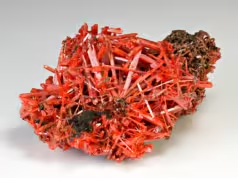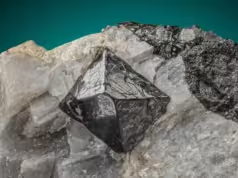Brucite is a mineral that is composed of magnesium hydroxide (Mg(OH)2). It belongs to the class of minerals known as hydroxides, which are compounds containing a metal cation and one or more hydroxide anions. Brucite specifically consists of magnesium ions (Mg2+) and hydroxide ions (OH-) in a 1:2 ratio.


Chemical Composition:
- Chemical Formula: Mg(OH)2
- Molecular Weight: 58.3197 g/mol
- Crystal System: Trigonal
Brucite is characterized by its hexagonal crystal structure, which gives rise to its trigonal symmetry. The mineral is often found in the form of platy or tabular crystals, but it can also occur in massive or fibrous habits.
Occurrence in Nature: Brucite is a relatively rare mineral, but it can be found in several geological environments. It is commonly associated with serpentinite deposits, which form through the alteration of ultramafic rocks rich in magnesium. The mineral can also be found in metamorphic rocks and occasionally in hydrothermal veins.
Some notable occurrences of brucite include regions like the Ural Mountains in Russia, the United States (particularly in California), Italy, and Greece. The mineral is typically white, gray, green, or blue-green in color, and its luster is often described as pearly or vitreous.
In addition to its natural occurrences, brucite can also be produced synthetically for various industrial applications. It has uses in the production of magnesium compounds, flame retardants, and as a neutralizing agent in acidic soils.
Contents
Geology and Formation

Brucite is typically formed through the alteration of magnesium-rich minerals in specific geological settings. Here is an overview of the geology and formation of brucite:
1. Serpentinite Alteration:
- One of the primary geological settings for the formation of brucite is in serpentinite deposits. Serpentinite is a metamorphic rock derived from the alteration of ultramafic rocks (such as peridotite) in the presence of water and high temperatures.
- The alteration of minerals like olivine in ultramafic rocks results in the release of magnesium ions (Mg2+), which combine with hydroxide ions (OH-) from water to form brucite (Mg(OH)2).
2. Metamorphic Processes:
- Brucite can also be found in metamorphic rocks as a result of metamorphic processes involving magnesium-rich precursor minerals.
- During metamorphism, minerals containing magnesium undergo changes in mineral composition and structure, leading to the formation of brucite.
3. Hydrothermal Veins:
- In some cases, brucite may be found in hydrothermal veins. Hydrothermal processes involve the circulation of hot fluids through rocks, leading to mineral alteration and the deposition of new minerals.
- Brucite can precipitate from hydrothermal fluids rich in magnesium and hydroxide ions under suitable temperature and pressure conditions.
4. Weathering and Soil Formation:
- Brucite can also form as a result of weathering processes, especially in areas with magnesium-rich rocks. The dissolution of magnesium-containing minerals by water can lead to the release of magnesium ions, which then react with hydroxide ions to form brucite.
- In soils, brucite may be present as a secondary mineral, contributing to the overall mineral composition of the soil.
5. Synthetic Production:
- Brucite can be produced synthetically for various industrial applications. This is often done by precipitating magnesium hydroxide from solutions containing magnesium salts, such as magnesium chloride or magnesium sulfate.
Understanding the geological processes and conditions under which brucite forms is crucial for both geological research and industrial applications. The mineral’s presence can provide insights into the geological history and conditions of a particular region.
Physical and Chemical Properties

Physical Properties of Brucite:
- Color: Typically white, gray, green, or blue-green.
- Luster: Pearly or vitreous.
- Transparency: Transparent to translucent.
- Crystal System: Trigonal.
- Crystal Habits: Often in the form of platy or tabular crystals, but can also occur in massive or fibrous habits.
- Hardness: Relatively soft with a Mohs hardness of about 2.5 to 3.
- Cleavage: Perfect basal cleavage, meaning it breaks easily along planes parallel to its basal structure.
- Fracture: Uneven to subconchoidal.
- Density: Relatively low density, typically around 2.38 g/cm³.
Chemical Properties of Brucite:
- Chemical Formula: Mg(OH)2.
- Composition: Composed of magnesium ions (Mg2+) and hydroxide ions (OH-) in a 1:2 ratio.
- Solubility: Insoluble in water, and it does not easily dissolve in acids.
- Stability: Stable under normal atmospheric conditions but can slowly weather and alter over time, particularly in the presence of acidic conditions.
- Flame Retardant Properties: Due to its ability to release water when heated, brucite is used as a flame retardant in certain applications.
Understanding these physical and chemical properties is essential for identifying and characterizing brucite in geological samples and industrial processes. The mineral’s unique properties, such as its flame-retardant capabilities, make it valuable in various applications.
Occurrence and Distribution of Brucite

- Serpentinite Deposits:
- Brucite is commonly associated with serpentinite deposits, which form through the alteration of ultramafic rocks like peridotite. The alteration process involves the release of magnesium ions, which combine with hydroxide ions to form brucite.
- Metamorphic Rocks:
- Brucite can be found in metamorphic rocks, particularly in areas where magnesium-rich minerals undergo metamorphic processes, leading to the formation of brucite as a secondary mineral.
- Hydrothermal Veins:
- In some instances, brucite may occur in hydrothermal veins. Hydrothermal fluids rich in magnesium and hydroxide ions can lead to the precipitation of brucite under suitable temperature and pressure conditions.
- Weathering and Soil Formation:
- Brucite can form as a result of weathering processes in areas with magnesium-rich rocks. The dissolution of magnesium-containing minerals by water can result in the release of magnesium ions, contributing to the formation of brucite.
- Specific Geological Locations:
- Notable occurrences of brucite include regions in the Ural Mountains in Russia, the United States (particularly in California), Italy, and Greece. These locations often have geological conditions conducive to the formation of brucite.
- Industrial Production:
- Brucite can also be produced synthetically for industrial purposes. The synthetic production often involves the precipitation of magnesium hydroxide from solutions containing magnesium salts, such as magnesium chloride or magnesium sulfate.
- Association with Carbonate Deposits:
- Brucite may also be found associated with carbonate deposits, as it can precipitate from solutions rich in magnesium and hydroxide ions in carbonate-rich environments.
Understanding the geological context and conditions under which brucite forms is crucial for identifying potential deposits and extracting it for various applications. The mineral’s occurrence in diverse geological settings makes it valuable in both geological research and industrial processes.
Uses and Applications

Brucite has several uses and applications, ranging from industrial processes to environmental and technological applications. Here are some of the key uses of brucite:
- Flame Retardants:
- Brucite is used as a flame retardant in various materials, including plastics, textiles, and coatings. When heated, brucite releases water vapor, which helps suppress combustion and reduce the spread of flames.
- Magnesium Compound Production:
- Brucite is a source of magnesium, and it can be processed to produce various magnesium compounds. These compounds find applications in industries such as pharmaceuticals, agriculture, and construction.
- Neutralizing Agent in Soil:
- Due to its alkaline nature, brucite is used as a soil amendment to neutralize acidic soils. It helps regulate soil pH and improve conditions for plant growth.
- Water Treatment:
- Brucite can be employed in water treatment processes. It reacts with acidic components in water, contributing to the removal of impurities and the adjustment of pH levels.
- Catalyst Support:
- Brucite is used as a support material for catalysts in certain chemical processes. Its properties make it suitable for providing a stable and inert environment for catalysts to function effectively.
- Health and Beauty Products:
- Brucite is used in certain health and beauty products, such as antacids and cosmetics, due to its alkaline and absorbent properties.
- Environmental Applications:
- The ability of brucite to sequester carbon dioxide makes it of interest in carbon capture and storage (CCS) applications. It can react with carbon dioxide to form magnesium carbonate, contributing to greenhouse gas mitigation efforts.
- Synthetic Rubber Production:
- Brucite can be used as a filler in the production of synthetic rubber. It enhances the physical properties of rubber compounds and improves their performance.
- Construction Materials:
- In construction materials, brucite can be used as a filler or as a component in products like mortar and concrete. Its incorporation can influence the properties of these materials.
- Research and Development:
- Brucite is also studied in various scientific and geological research projects to understand its formation, properties, and potential applications in emerging technologies.
The diverse applications of brucite highlight its versatility and importance in various industries, ranging from fire safety to agriculture and environmental sustainability.




































